Abstract
The Jurassic Tamulangou Formation in the Hongqi Depression has favorable hydrocarbon generation conditions and great resource potential. This study systematically analyzes the geochemical characteristics and thermal evolution history of the source rocks using data from multiple key wells. The dark mudstone of the Tamulangou Formation has a thickness ranging from 50 to 200 m, with an average total organic carbon (TOC) content of 0.14–2.91%, an average chloroform bitumen “A” content of 0.168%, and an average hydrocarbon generation potential of 0.13–3.71 mg/g. The organic matter is primarily Type II and Type III kerogen, with an average vitrinite reflectance of 0.71–1.36%, indicating that the source rocks have generally reached the mature hydrocarbon generation stage and are classified as medium-quality source rocks. Thermal history simulation results show that the source rocks have undergone two major thermal evolution stages: a rapid heating phase from the Late Jurassic to Early Cretaceous and a slow cooling phase from the Late Cretaceous to the present. There are differences in the thermal evolution history of different parts of the Hongqi Depression. In the southern part, the Tamulangou Formation entered the hydrocarbon generation threshold at 138 Ma, reached the hydrocarbon generation peak at approximately 119 Ma, and is currently in a highly mature hydrocarbon generation stage. In contrast, the central part entered the hydrocarbon generation threshold at 128 Ma, reached a moderately mature stage around 74 Ma, and has remained at this stage to the present. Thermal history simulations indicate that the Hongqi Depression reached its maximum paleotemperature at 100 Ma in the Late Early Cretaceous. The temperature evolution pattern is characterized by an initial increase followed by a gradual decrease. During the Late Jurassic to Early Cretaceous, the Hongqi Depression experienced significant fault-controlled subsidence and sedimentation, with a maximum sedimentation rate of 340 m/Ma, accompanied by intense volcanic activity that created a high-temperature geothermal gradient of 40–65 °C/km, with paleotemperatures exceeding 140 °C and a heating rate of 1.38–2.02 °C/Ma. This thermal background is consistent with the relatively high thermal regime observed in northern Chinese basins during the Late Early Cretaceous. Subsequently, the basin underwent uplift and cooling, reducing subsidence and gradually lowering formation temperatures.
1. Introduction
The Hailar Basin, located in southwestern Hulunbuir, Inner Mongolia, is a Mesozoic–Cenozoic continental fault basin that developed on the Paleozoic Xingmeng Orogenic Belt. It is rich in petroleum, coal, and other resources. Significant oil and gas discoveries have been made in the Urxun, Beier, and Huhenuo sags in the southern part of the basin, with annual production exceeding 400,000 tons, making it an important area for oil and gas exploration in the Daqing Oilfield [1,2].
Currently, hydrocarbon exploration in the Hailar Basin has primarily focused on the Cretaceous play. Previous studies have extensively investigated the geological structure, source rocks, reservoir distribution, hydrocarbon migration, and accumulation, leading to the identification of seven oil-bearing zones: Huhenuo, Suderte, Huodomoer, Beizhong, Surennuoer, Wudong, and Bayantala [2,3,4,5,6,7,8]. However, after more than 60 years of continuous exploration, the main oil-bearing formations in the Cretaceous have entered the mid-to-late development stage, with shallow, large-scale, easily discoverable structural oil reservoirs being almost fully explored. Consequently, exploration efforts are shifting from the shallow Cretaceous to the deeper Jurassic play.
In recent years, oil stains and hydrocarbon shows have been observed in the Jurassic Wanbao Formation in the adjacent Tuquan Basin. In the Erlian Basin, 17 Jurassic wells have shown oil and gas indications, with two yielding low oil production [9]. Jurassic oil and gas exploration in the Hongqi Depression of the Hailar Basin has resulted in significant hydrocarbon shows in wells Hong D3, Hong 2, Hong 5, and Haishen 6, with industrial oil flows observed in well Hong 7. Additionally, well Hong 6 in the southern part of the sag produced low-yield oil from the Upper Jurassic Tamulangou Formation. Oil-source correlation studies indicate that hydrocarbons are derived from the Tamulangou Formation, forming a lower-generation, upper-reservoir hydrocarbon accumulation model [10]. Although previous studies have examined the structural characteristics, sequence stratigraphy, sedimentary systems, source rocks, and oil-source correlation in the Hongqi Depression [10,11,12,13,14], a systematic analysis of the geochemical characteristics and thermal evolution history of the Tamulangou Formation source rocks is still lacking, which constrains further exploration progress.
Source rocks are fundamental to hydrocarbon accumulations. The evaluation of source rock geochemical characteristics and thermal evolution history is essential for hydrocarbon resource assessment and has been a crucial research focus in petroleum geology [15,16,17,18,19,20,21,22]. This study systematically evaluates organic matter abundance, kerogen types, and maturity using organic geochemical methods [23,24,25,26]. The EasyRo% method is applied to reconstruct the thermal evolution history of Jurassic source rocks in the Hongqi Depression [27,28,29], determining key parameters such as maximum geothermal gradient, peak paleotemperature, and hydrocarbon generation history. These findings provide important theoretical and practical implications for hydrocarbon exploration in the region.
2. Regional Geological Background
The Hailar Basin is situated in southwestern Hulunbuir, Inner Mongolia, extending from the western shore of Hulun Lake and Bayan Hushu to the east as far as the Yimin River, and from Chenbarhu banner in the north to Beier Lake in the south, extending into Mongolia. It forms part of the Central Asia–Mongolia extension-driven basin system, with the Derbugan Fault marking its boundary. To the west, it belongs to the Erguna fold belt, while to the east, it aligns with the Inner Mongolia–Daxing’anling fold belt. The basin is a superimposed Mesozoic–Cenozoic fault depression developed on a Hercynian fold basement [30,31], experiencing two major evolutionary stages: rifting and sagging [5,32]. During the Jurassic, mantle uplift transformed the tectonic regime from a compressional state to an extensional state, accompanied by extensive volcanic activity [8]. In the Early Cretaceous, the basin reached its peak rifting stage, experiencing distinct evolutionary stages: intense extension during the Tongbomiao Formation deposition, rapid extension during the Nantun Formation deposition, stable extension during the Damoguaihe Formation deposition, and overall uplift and contraction during the Yimin Formation deposition. This period was characterized by active faulting, frequent volcanism, an expanding depositional area, and progressively deepening water bodies, leading to the accumulation of thick sedimentary sequences in the rift center. From the Late Cretaceous to the present, the basin entered a sagging stage, undergoing regional compressional uplift [8]. Under nearly east–west compressional stress, the fault basin experienced structural inversion, resulting in the deposition of a fluvial–swamp facies sequence consisting of conglomerates, sandstones, and mudstones.
The Hailar Basin currently exhibits a structural pattern characterized by two lifted up domains and three depression domains, namely, the Zalainuoer Depression, Cuogang Uplift, Beier Lake Depression, Bayanshan Uplift, and Huhenuo Depression. The primary structural units are further subdivided into 16 sags and 4 uplifts [5,32]. The Hongqi Depression is located in the northern part of the Hailar Basin and is classified as a secondary structural unit within the basin. It is an NE-trending half-graben fault depression, with a steep faulted boundary to the north and a gentle slope to the south, forming a “two sags and one uplift” structural pattern, with developed southern and northern sub-sags (Figure 1a). The total area of the Hongqi Depression is approximately 840 km2. Stratigraphically, from bottom to top, the formations present are the Jurassic Tamulangou Formation (J3tm), Cretaceous Tongbomiao Formation (K1t), Nantun Formation (K1n), Damoguaihe Formation (K1d), Yimin Formation (K1y), Qingyuangang Formation (K2q), Paleogene, Neogene, and Quaternary strata (Figure 1b,c). The effective Jurassic hydrocarbon source layer is the Tamulangou Formation.
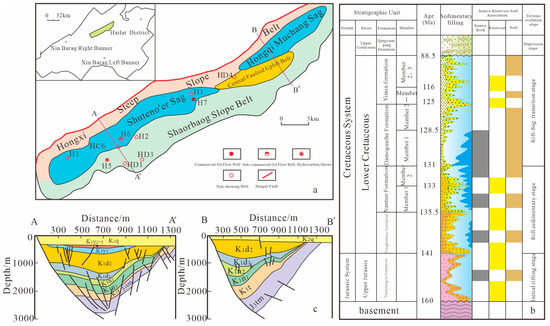
Figure 1.
(a) Structural unit division and well distribution in the Hongqi Depression; (b) tratigraphic column; (c) structural profile map.
3. Data and Methods
In this work, all of the analyzed source rock samples from the J3tm formation were collected from Hongqi Depression in the Hailar Basin (Figure 1a). The samples from three wells (H6, H7, and H8) with depths from 2200 m to 3565 m consist of 87 mudstone samples and were used for Rock-Eval pyrolysis and the determination of total organic carbon content (%), chloroform bitumen “A” (%), kerogen carbon isotope “δ13CPDB”, total reduced sulfur, and vitrinite reflectance (Ro%). All mudstone samples were pulverized to 100 mesh in preparation for those experiments.
Rock-Eval/TOC was conducted at the State Key Laboratory of Continental Dynamics, Department of Geology, Northwest University and provided the measurements of TOC (wt%), Tmax, S1 and S2. The temperature was set to 300 °C for 3 min and then heated up to 600 °C at a rate of 25 °C/min. Tmax represents the temperature that corresponds to the maximum generation rate of hydrocarbons from kerogen cracking. S1 represents any free hydrocarbons. S2 represents the amount of hydrocarbons expelled from kerogen cracking. Some parameters were then generated from the Rock-Eval pyrolysis techniques: Hydrogen index [HI = (S2/TOC) × 100, mgHC/g TOC] is the normalized S2 value (S2/TOC), indicating the potential of kerogen in a rock to generate petroleum [33,34]. The TRS of source rocks was measured using a LECO CS-230 analyzer (LECO Corporation, St. Joseph, MI, USA). The results are listed in the Table 1.

Table 1.
Geochemical data of the Jurassic Tamulangou Formation source rocks in the Hongqi Depression.
Kerogens separated from mudstones were used for observations and testing with a DLAPLAN biological microscope (Leica Microsystems GmbH, Wetzlar, Germany). They were also used for thin sections in preparation for vitrinite reflectance (Ro%) determinations and were placed under reflected light in a ZEISS Axio Microscope (Carl Zeiss AG, Oberkochen, Germany). The vitrinite reflectance measurement system used a TIDAS PMT IV photometer (J&M Analytik AG, Essingen, Germany) and MSP200 testing software (Version 3.47). The detailed methods, experimental conditions, and algorithm for selecting the appropriate values were optimized. The results are shown in Table 1. To more accurately assess organic matter types and depositional conditions, kerogen carbon isotope (δ13CPDB) analyses were conducted with an MAT-251 Stable Isotope Mass Spectrometer (Finnigan MAT, Waltham, MA, USA). The chloroform bitumen “A” was determined using the Soxhlet extraction method. The rock samples were crushed to 0.09 mm powder, extracted with chloroform continuously for 72 h, and then dried to calculate the content of soluble organic matter in the unit rock.
Additionally, gas chromatography (GC) data were also collected from the J3tm formation from three wells in the Hongqi Depression. The GC results are listed in Table 2. The rock samples were cleaned prior to powdering, and the saturated hydrocarbons and aromatic hydrocarbons were then extracted using the column chromatography method. The GC heating process for the saturated fractions was as follows: the initial temperature was held at 35 °C and then increased to 120 °C at 10 °C/min, which was followed by a second increase to 300 °C at 3 °C/min for 30 min. Biomarker analyses of saturated hydrocarbons were conducted by using a Finnigan–Voyager gas chromatograph (Finnigan Corporation, Palo Alto, CA, USA). All of the analytical measurements except for Rock-Eval/TOC were conducted at the Research Institute of Exploration and Development, Daqing Oilfield.

Table 2.
Chromatographic parameter table of the Jurassic Tamulangou Formation source rocks in the Hongqi Depression, Hailar Basin.
Thermal burial history modeling was performed using the method introduced by Lopatin (1971) [35], which was modified and calibrated by using vitrinite reflectance measurements, stratigraphic sequences, and geologic time in million [36]. Sweeney and Burnham (1990) put forward a vitrinite maturation model (Easy% Ro), which is widely applied to predict the levels of thermal maturity evolution history [37]. The thermal history simulations in this study were conducted using Petro-Mod software (Version 2016.2) purchased by the Department of Geology at Northwestern University. The thermal history results are based on the parameters of thermal history simulation: current geothermal gradient, current geothermal flow value, paleogeothermal gradient, paleogeothermal flow value, and stratigraphic data and age, combined with measured vitrinite reflectance for simulation.
4. Results and Discussion
4.1. Organic Matter Content
The total organic carbon (TOC) content, chloroform bitumen “A”, and hydrocarbon generation potential are the primary parameters for evaluating the organic matter abundance of source rocks [38,39,40]. The Jurassic Tamulangou Formation source rocks in the Hongqi Depression are widely distributed and have substantial thicknesses, with dark mudstone layers generally ranging from 50 to 200 m. In the southern Shutenuoer Depression, the cumulative thickness of dark mudstone exceeds 200 m, while in the northern Hongqi Ranch Depression, it surpasses 300 m [14]. In this study, a systematic collection and analysis of geochemical test data from 87 samples obtained from three key boreholes in the Hongqi Depression were conducted (Table 1). The TOC content of Jurassic Tamulangou Formation dark mudstones typically ranges from 0.098% to 4.27%, with an average variation between 0.14% and 2.91%. The average chloroform bitumen “A” content is 0.168%, and the average hydrocarbon generation potential (S1 + S2) is 2.38 mg/g. The mean vitrinite reflectance (Ro) varies between 0.71% and 1.36%, indicating that the dark mudstones have generally entered the mature oil generation stage. Notably, the mean vitrinite reflectance of the dark mudstones in Well Hong-6, located in the central Shutenuoer Depression, exceeds 1.3%, signifying a high-maturity oil generation stage. According to the organic matter abundance evaluation criteria for continental source rocks (SY/T5735-1995), the dark mudstones of the Jurassic Tamulangou Formation are classified as moderately productive source rocks with considerable hydrocarbon generation potential.
4.2. Organic Matter Type
The types of organic matter in source rocks are generally classified into Type I, Type II, and Type III. Different types of organic matter not only exhibit variations in hydrocarbon generation potential but also produce distinct hydrocarbon component characteristics [41,42,43,44]. Based on the elemental analysis of organic matter in the Hongqi Depression, the H/C and O/C atomic ratios, as well as the relationship between pyrolysis Tmax and hydrogen index (IH) (Figure 2), the organic matter in the Jurassic Tamulangou Formation source rocks is primarily composed of Type II and Type III kerogen. This indicates that these source rocks contain both hydrogen-rich components derived from lower aquatic organisms and hydrogen-rich maceral components from higher plants, suggesting a favorable potential for oil and gas generation.
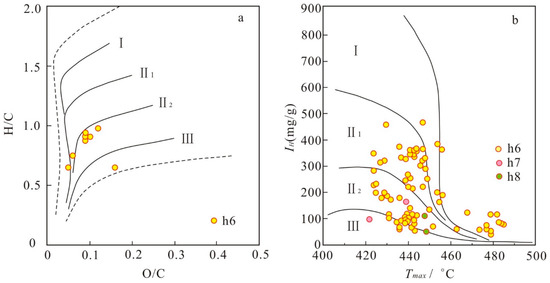
Figure 2.
(a) Elemental composition of kerogen in the Tamulangou Formation and (b) kerogen type diagram.
In addition, kerogen carbon isotopes are stable during the diagenetic process and can reflect the original material composition of the organic matter. Therefore, the type of organic matter can be inferred based on the carbon isotope characteristics of kerogen [45,46,47]. The carbon isotope composition of Type I kerogen, derived from algae, is typically light, generally less than −28‰, while Type III kerogen, derived from terrestrial higher plants, has a heavier carbon isotope composition, generally greater than −25‰. Type II kerogen falls between these two. The carbon isotope analysis of kerogen shows that the kerogen carbon isotopes in the dark mudstones of the Tamulangou Formation range from −27.52‰ to −21.37‰, indicating that the organic matter is primarily Type II and Type III (Table 1, Figure 3).
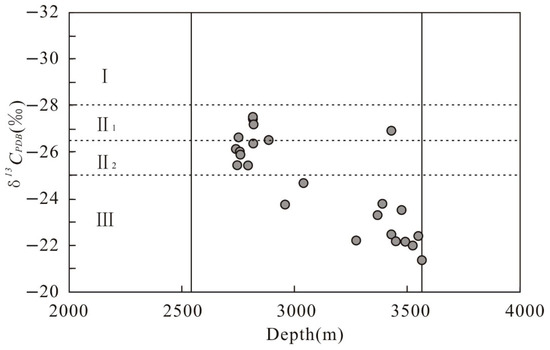
Figure 3.
Kerogen carbon isotopes of the dark mudstones in the Tamulangou Formation.
4.3. Organic Matter Maturity
Vitrinite reflectance (Ro) is a primary parameter for evaluating organic matter maturity [48,49,50,51]. In this study, a detailed analysis was conducted on the vitrinite reflectance data from five wells with extensive data in the sag, totaling 90 data points. The relationship between vitrinite reflectance and depth was analyzed in depth, showing a clear linear trend. As depth increases, the vitrinite reflectance values correspondingly increase. The reflectance values are primarily controlled by the maximum formation temperature and burial depth (Figure 4).

Figure 4.
Thermal evolution and hydrocarbon expulsion profile of source rocks in the Hongqi Depression.
From the thermal evolution and hydrocarbon expulsion profile of the source rocks in the Hongqi Depression, both the Carbon Preference Index (CPI) and Odd–Even Preference (OEP) decrease with increasing burial depth, approaching 1.0 around 2100 m. The hydrocarbon generation threshold is at 1350 m, the hydrocarbon expulsion threshold is at 1950 m, and the peak of hydrocarbon generation occurs at 2800 m. The vitrinite reflectance values of the dark mudstones in the Tamulangou Formation range from 0.8% to 2.0%, indicating that they are generally in the mature-to-highly mature stage. Currently, they are at the peak of hydrocarbon generation, with some areas having entered the over-mature stage (Figure 4). The maturity evolution trend of the Tamulangou Formation is significantly different from that of the overlying Tongbomiao Formation and Nantun Formation, showing a rapid increase in maturity. This is directly related to the volcanic activity that influenced the deposition of this stratigraphic sequence during its formation [52].
4.4. The Composition Characteristics of Soluble Organic Matter
The characteristics of soluble organic matter in source rocks are of significant importance for understanding the source parent material, depositional environment, and maturation evolution of source rocks. The analysis of the compositional characteristics of chloroform extracts from the Jurassic Tamulangou Formation source rocks in the Hongqi Depression, Hailar Basin, shows (Table 3) that the saturated hydrocarbon content of the Tamulangou Formation source rocks ranges from 36.89% to 71.61%, aromatic hydrocarbon content ranges from 8.56% to 20.53%, non-hydrocarbon content ranges from 6.41% to 32.74%, and asphaltene content ranges from 0.87% to 23.51%. The combined content of non-hydrocarbons and asphaltenes ranges from 8.74% to 51.46%. The large variation in saturated hydrocarbon content reflects the diverse types of organic matter in this region.

Table 3.
Compositional analysis data of the source rocks in the Jurassic Tamulangou Formation, Hongqi Depression.
4.5. Biomarker Characteristics
Biomarkers are organic compounds that undergo little or no change during the organic matter evolution process. They have unique and stable carbon skeletons, preserving the molecular structures of the original biological parent material. Due to their stable structural characteristics, biomarkers are widely used as indicators for evaluating parent material type, depositional environment, maturity, and other factors [53]. The chromatographic-mass spectrometry results of the Tamulangou Formation source rocks show that the distribution of alkanes is unimodal, with carbon numbers ranging from nC13 to nC35. The main peak occurs at nC19, with smaller peaks at nC21 and nC23, indicating the input of both lower aquatic organisms and terrestrial higher plants. The Pr/Ph ratio ranges from 0.69 to 1.39, and hopane characteristics show that Ts > Tm, with a notable peak in C30 hopane, suggesting that the oil-generating parent material was deposited in a mixed organic matter-dominated, weakly oxidizing to weakly reducing transitional environment. The stable carbon isotope δ13C in the mudstone ranges from −27.52‰ to −21.37‰, indicating that the organic matter is primarily derived from lacustrine planktonic algae. The Pr/nC17-Ph/nC18 relationship further shows that the oil-generating parent material has mixed input characteristics from both algae and terrestrial higher plants (Figure 5).
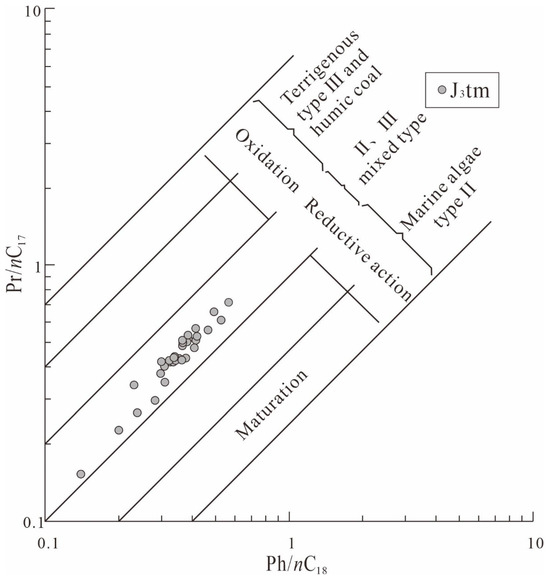
Figure 5.
Pr/nC17-Ph/nC18 relationship diagram of source rocks in the Tamulangou Formation, Hongqi Depression.
4.6. Thermal Evolution History
4.6.1. Geothermal Gradient
The present geothermal field serves as the basis for restoring the basin’s paleogeothermal field [54,55]. The current geothermal gradient of the Hongqi Depression is 40 °C/km [56]. Based on the relationship established by Barker and Pawlewicz between the maximum burial temperature (Tmax) and vitrinite reflectance (Ro), ln (Ro) = 0.0096Tmax − 1.4, the maximum burial temperature was calculated [57]. As depth increases, the maximum burial temperature also increases, showing a clear linear relationship. The determined paleogeothermal gradient is 40–65 °C/km (Figure 6). The paleogeothermal gradient is higher than the present-day geothermal gradient, indicating that the paleotemperature was higher than the present temperature, and since the Mesozoic, there has been a gradual cooling process [58].
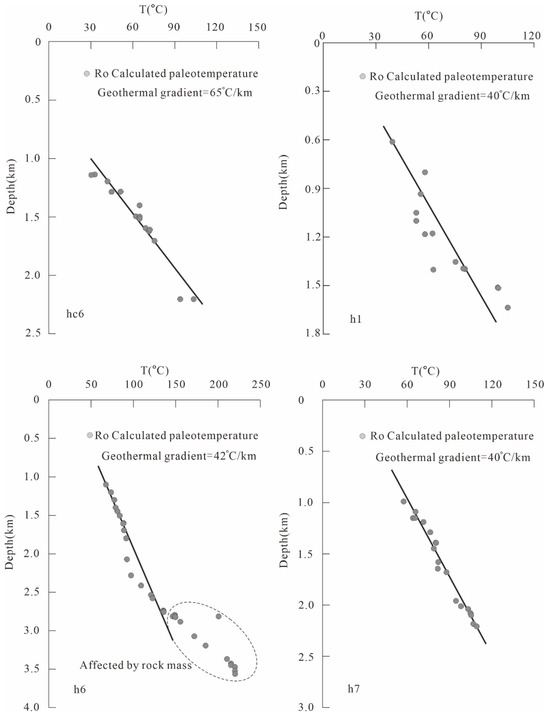
Figure 6.
Relationship diagram of paleogeothermal temperature calculated from vitrinite reflectance (Ro) and depth.
4.6.2. Erosion Thickness
Erosion thickness is the basis for restoring the burial history. Currently, there are many methods to determine erosion thickness, including the acoustic time difference method, the vitrinite reflectance method, and the stratigraphic trend method. Using the acoustic time difference method and stratigraphic trend method, the erosion thickness at the end of the deposition of the Yimin Formation in the Hongqi Depression was determined to be 0–300 m [59], with minimal erosion at the center of the sag and greater erosion at the edges. The erosion thickness determined through vitrinite reflectance in this study ranges from 162 m to 200 m (Figure 7), which is consistent with the erosion thickness obtained using the acoustic time difference method and stratigraphic trend method.
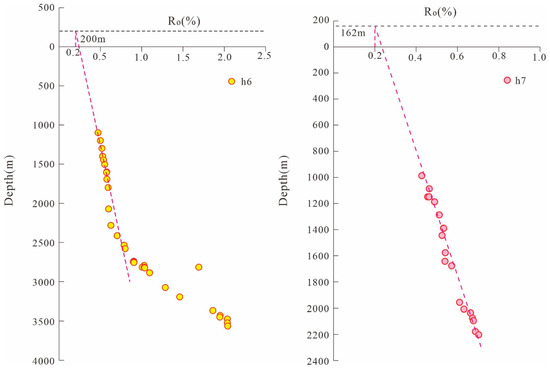
Figure 7.
Erosion thickness restoration diagram for wells H6 and H7.
4.6.3. Thermal History Simulation
Currently, the Easy%Ro method proposed by Sweeney & Burnham (1990) [37] is the most accurate approach for thermal history simulation [31,46,55]. By using a single-well simulation method, the theoretically calculated Ro values are matched with the measured data, adjusting geological model parameters until the theoretical and measured Ro trends achieve the best fit. This method can therefore be used to infer paleogeothermal gradient values [49,60].
In this thermal history simulation, stratigraphic thickness, geological age, and erosion thickness during key periods were used as important constraints. Combined with geothermal field parameters and measured vitrinite reflectance values, Petro-Mod simulation software was applied using the Easy%Ro method to simulate the thermal history of Well Hong 7 in the central sag and Well Hong 6 in the southern sag. The simulated Ro values closely match the measured Ro values, indicating reliable results.
The thermal history simulation indicates that the source rocks of the Tamulangou Formation in the Hongqi Depression have undergone two main thermal evolution stages: a rapid heating phase during the Late Jurassic–Early Cretaceous and a slow cooling phase from the Late Cretaceous to the present (Figure 8). The simulation results reveal certain differences in thermal evolution history across different locations. Well H6, located in the southern part of the Hongqi Depression, shows that the Tamulangou Formation source rocks entered the hydrocarbon generation threshold at 138 Ma, with Ro reaching 0.5%. Around 119 Ma, they entered the hydrocarbon generation peak, with Ro reaching 1.0% and the maximum paleotemperature exceeding 140 °C. At present, they are in a highly mature hydrocarbon generation stage (Figure 9). Well H7, situated in the central part of the Hongqi Depression, indicates that the Tamulangou Formation source rocks reached the hydrocarbon generation threshold at 128 Ma, with Ro reaching 0.5%. Around 74 Ma, they entered the moderately mature stage, which has continued to the present, with Ro reaching 0.7% (Figure 10).
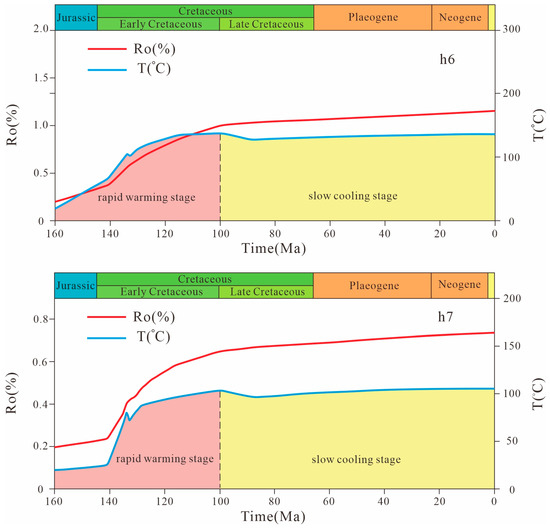
Figure 8.
Relationship diagram of maturity, temperature, and time in the Hongqi Depression.
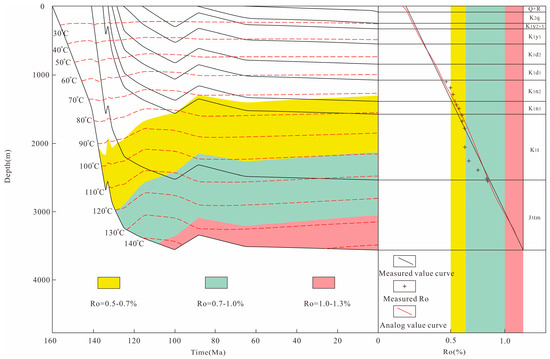
Figure 9.
Thermal history of H6 in the Hongqi Depression.
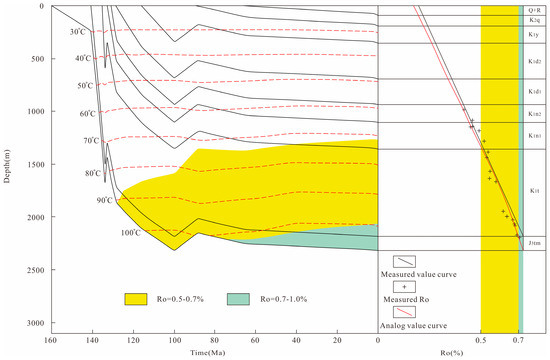
Figure 10.
Thermal history of H7 in the Hongqi Depression.
5. Discussion
The Hailar Basin is located in the western part of Northeast China. By the end of the Paleozoic, the region had completed its marine sedimentary evolution, forming a unified Paleozoic basement [9]. During the Early to Middle Jurassic, Northeast China was under a tectonic regime influenced by the flat subduction of the Paleo-Pacific Plate and the compression-extension effects caused by the closure of the Okhotsk Ocean. In the Late Jurassic, the region was primarily controlled by the Paleo-Pacific Plate, undergoing widespread intracontinental extension accompanied by extensive volcanic activity. The Hongqi Depression developed as a Mesozoic rifting controlled by basement faults [8]. The Tamulangou Formation was deposited during the initial rifting stage of the Hongqi Depression. The geochemical characteristics of siltstone mudstone and mudstone within the Tamulangou Formation indicate Sr/Ba values ranging from 0.25 to 0.49, suggesting a freshwater to brackish depositional environment. The Rb/Sr values range from 0.12 to 1.36, reflecting strong chemical weathering and a humid climate [14]. Under warm and humid climatic conditions, lacustrine lower aquatic organisms and higher plants thrived, leading to high paleo-productivity in the lake system, which provided abundant organic matter for hydrocarbon source rock formation. The V/Ni values range from 2.66 to 6.28, indicating that the Tamulangou Formation source rocks were deposited in a weakly oxidizing to weakly reducing environment [14]. As the depression continued to subside and the lacustrine basin deepened, the hydrocarbon source rock sequences were deposited in a brackish water environment under shore-shallow lake to semi-deep lake conditions. The weakly oxidizing to weakly reducing conditions facilitated the preservation of organic matter, resulting in source rocks with high content of organic matter of type Ⅲ.
The sedimentation rates of Hong 6 (Figure 11a) and Hong 7 (Figure 11b) wells were simulated using Petro-Mod software, and the sedimentation rate from the Tamulangou Formation to the present day was calculated. During the Late Jurassic to Early Cretaceous, the Hailar Basin was in a stable rifting stage, with continuous subsidence, increasing sedimentation rates, and a gradually rising geothermal gradient. During this period, the Hongqi Depression experienced stable rifting extension, characterized by rapid and large-scale subsidence and sedimentation, with a maximum sedimentation rate of 340 m/Ma (Figure 11b). Intense fault activity, accompanied by significant volcanic eruptions, led to a high geothermal regime, with a geothermal gradient of 40–65 °C/km and paleo-temperatures exceeding 140 °C (Figure 8). The heating rate reached 1.38–2.02 °C/Ma (Figure 8), bringing the source rocks to their maximum thermal evolution stage. This high thermal background is generally consistent with the Mesozoic thermal evolution observed in most northern Chinese basins. For instance, the Erlian Basin had a maximum Early Cretaceous paleo-geothermal gradient of 50–58 °C/km [55], while the Songliao Basin recorded an Early Cretaceous maximum paleo-geothermal gradient of 48–50 °C/km [61]. The tectonic setting of Northeast China during this time was influenced by the subduction of the Kula–Pacific Plate and the expansion and closure of the Okhotsk–Mohe–Mongolian Ocean. This resulted in an extensional tectonic environment, mantle upwelling, crustal thinning, and strong magmatic activity, all contributing to a high thermal regime [62,63,64,65].
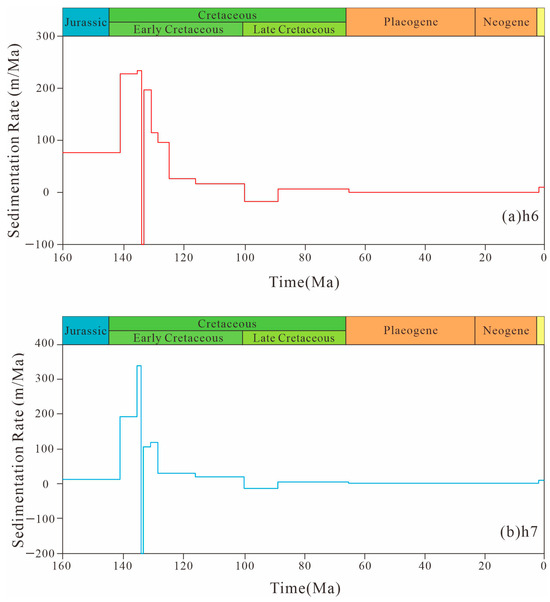
Figure 11.
Sedimentation rate diagram of the Hongqi Depression. (a) Sedimentation rate diagram of H6 in the Hongqi Depression; (b) Sedimentation rate diagram of H7 in the Hongqi Depression.
Since the Late Cretaceous, the Hongqi Depression has entered a sag development stage. Under the influence of an NW-SE compressional stress field, the strata experienced uplift and erosion, leading to a decrease in formation temperature and a weakening of hydrocarbon generation in the source rocks. However, due to the relatively small erosion thickness and the deep burial of the overlying strata, the formation temperature in the central part of the sag remained high, reaching 100–140 °C, allowing continuous hydrocarbon expulsion from the source rocks. Oil-source correlation analysis indicates a strong genetic relationship between the Lower Cretaceous Tongbomiao Formation crude oil in Well H6 of the Hongqi Depression and the underlying Upper Jurassic Tamulangou Formation source rocks. This relationship supports a hydrocarbon accumulation model characterized by “lower generation and upper reservoir” [10].
6. Conclusions
- (1)
- The dark mudstone of the Jurassic Tamulangou Formation in the Hongqi Depression has a thickness ranging from 50 to 200 m. The total organic carbon (TOC) content varies between an average of 0.14% to 2.91%. The chloroform bitumen “A” content averages 0.168%, and the hydrocarbon generation potential (S1 + S2) averages between 0.13 to 3.71 mg/g. The kerogen carbon isotope values range from −27.52‰ to −21.37‰. The organic matter type is mainly Type II and Type III, with the source material coming from both low-level aquatic organisms like algae and higher terrestrial plants. The vitrinite reflectance (Ro) averages between 0.71% and 1.36%. Overall, the source rocks have entered the mature oil generation stage, and the source rock is evaluated as being of medium quality.
- (2)
- The thermal history simulation results show that the Hongqi Depression’s Tamulangou Formation source rock has undergone two main thermal evolution stages since its deposition: a rapid warming stage during the Late Jurassic to Early Cretaceous and a slow cooling stage from the Late Cretaceous to the present. The thermal evolution history varies across different locations. In the southern part of the sag, the thermal evolution is more advanced. The Jurassic Tamulangou Formation source rock reached the hydrocarbon generation threshold at 138 Ma, peaked around 119 Ma with Ro reaching 1.0%, and the maximum paleo-temperature exceeded 140 °C. It is currently in the high-maturity oil generation stage. In the central part of the sag, the thermal evolution is less advanced. The source rock reached the hydrocarbon generation threshold at 128 Ma, entered the medium-maturity stage around 74 Ma, and has remained in this stage ever since.
- (3)
- During the Late Jurassic to Early Cretaceous, the Hailar Basin was in a stable rifting stage, characterized by significant and rapid subsidence and sedimentation. The maximum sedimentation rate reached 340 m/Ma, accompanied by intense volcanic activity, which created a high geothermal field. The geothermal gradient reached 40–65 °C/km, with paleo-temperatures exceeding 140 °C, and the warming rate was 1.38–2.02 °C/Ma. The source rock reached its maximum thermal evolution stage, which is consistent with the relatively high thermal background during the late Early Cretaceous in northern China basins. Afterward, the basin uplifted and cooled, with a decrease in subsidence and a gradual reduction in the formation temperature. The temperature evolution showed a pattern of first increasing and then decreasing.
Author Contributions
Data collection and analysis, W.J.; data analysis, discussion, and result analysis, J.C., H.T. and Z.R.; article writing, J.C.; cartography and translation, H.T., H.S. and W.G. All authors have read and agreed to the published version of the manuscript.
Funding
This study was supported by the General Program of the National Natural Science Foundation of China (No. 41772121) and the Key Program of the National Natural Science Foundation of China (No. 41630312).
Institutional Review Board Statement
Not applicable.
Informed Consent Statement
Not applicable.
Data Availability Statement
All data related to this manuscript have been fully submitted to and are available from the editorial board.
Conflicts of Interest
Author Wei Jin was employed by the company China National Petroleum Corporation. The remaining authors declare that the research was conducted in the absence of any commercial or financial relationships that could be construed as a potential conflict of interest.
References
- Li, C.B. Petroleum Exploration History and Enlightenment in Hailar Basin. Xinjiang Pet. Geol. 2021, 42, 374–380. [Google Scholar]
- Wang, X.J.; Meng, Q.A.; Li, Y.; Wu, H.B.; Li, J.H.; Deng, H.; Shen, W.J.; Chen, F.J.; Hou, S.Y.; Zhang, S.Q. New fields, new types and resource potentials of oil-gas exploration and development in Hailaer Basin. Acta Pet. Sin. 2024, 45, 99–114. [Google Scholar]
- Zhang, J.G.; Zhang, B.X.; Chen, P. Surrenurrenurren system in the Hailar Basin. Pet. Explor. Dev. 1998, 1, 41–44. [Google Scholar]
- Feng, Z.Q.; Zhang, X.D.; Ren, Y.G.; Wu, H.Y.; Li, C.B.; Dong, B.W. Hydrocarbon reservoir forming characteristics and distribution rule of Hailar Basin. Pet. Geol. Oilfield Dev. Daqing 2004, 5, 16–19. [Google Scholar]
- Chen, J.L.; Wu, H.Y.; Zhu, D.F.; Lin, C.H.; Yu, D.S. Tectonic evolution and prospects for hydrocarbon exploration in the Hailar Basin. Sci. Geol. Sin. 2007, 1, 147–159. [Google Scholar]
- Fu, X.F.; Dong, J.; Lv, Y.F.; Sun, Y.H. Fault Structural Characteristics of Wuerxun-Beier Depression in the Hailar Basin and Their Reservoir-Controlling Mechanism. Acta Geol. Sin. 2012, 86, 877–889. [Google Scholar]
- Cui, X.; Li, J.H.; Jiang, H.F.; Xu, L.; Zhang, H.W.; Wang, H. Characteristics of the volcanic basement reservoirs and its hydrocarbon accumulation mode in Sudeert structural belt, Hailar Basin, China. Nat. Gas Geosci. 2016, 27, 1466–1476. [Google Scholar]
- Cui, J.P.; Zhao, J.; Ren, Z.L.; Jin, W.; Xing, L.; Wang, Y.Q. Geochemical Characteristics of Lower Cretaceous Source Rocks and Thermal History in the Huhehu Depression, Hailar Basin. Earth Sci. 2020, 45, 238–250. [Google Scholar]
- Jia, J.H.; Tao, S.Z.; Fang, X.; Hou, Y.P. Deep Jurassic volcano-sedimentary succession, reservoir-seal assemblage and their exploration significance in Northeast China: A case study of Jurassic in the Hailar basin. Acta Geol. Sin. 2021, 95, 377–395. [Google Scholar]
- Wu, H.B.; Hou, Y.P.; Wang, P.J.; Chen, H.P.; Shen, W.J.; Peng, W.; Chen, C.Y. Hydrocarbon source in Jurassic and its exploration significance in Hongqi Depression, Hailar Basin. World Geol. 2023, 42, 676–690. [Google Scholar]
- Liu, Z.H.; Huang, C.Y.; Wang, P.; Wu, X.M.; Mei, M.; Zhou, F. Structural Features and Determination of Deformation Stages of Hongqi Depression in Hailar Basin During the Early Cretaceous. J. Jilin Univ. Earth Sci. Ed. 2011, 41, 327–334. [Google Scholar]
- Liu, H.L.; Li, Z.Q.; Peng, Y.; Meng, Q.A.; Li, J.S.; Chen, J.L.; Zhong, R.Q.; Li, Q.Q. Structural physical simulation and structural evolution characteristics of typical profile in Hongqi Depression, hailaer basin. Mineral. Petrol. 2020, 40, 92–106. [Google Scholar]
- Yang, X.; Shen, W.J. Characteristics and evolution of the structural formations in Hongqi Depression, Hailar Basin. Pet. Geol. Oilfield Dev. Daqing 2021, 40, 20–27. [Google Scholar]
- Xie, M.X.; Chen, G.P.; Su, Y.P. Characteristics and Development Model of Jurassic Source Rocks of Hailar Basin: Case Study in Hongqi Depression. J. Jilin Univ. Earth Sci. Ed. 2022, 52, 1065–1077. [Google Scholar]
- Yalcin, M.N.; Welte, D.H. The thermal evolution of sedimentary basins and significance for hydrocarbon generation. Geophys. J. Int. 1988, 1, 12–26. [Google Scholar]
- Qiu, N.S.; Wang, J.Y.; Zhou, L.C.; Zhang, Q.M.; Chen, G.Y.; Cai, S.X. Thermal evolution of organic matter in source rocks of sedimentary basins using electron paramagnetic resonance methods. Chin. Sci. Bull. 1995, 11, 1013–1015. [Google Scholar]
- Zhu, Y.M.; Qin, Y.; Fan, B.H.; Jiang, B.; Li, T.Z. Hydrocarbon-generation evolution of Paleozoic source rocks in the deep zone of Huanghua Depression. Chin. J. Geol. 2001, 36, 435–443. [Google Scholar]
- Wang, F.Y.; Shui-chang, Z.; Zhang, B.M.; Xiao, Z.Y.; Liu, C.W. Maturity and its history of Cambrian marine source rocks in the Tarim Basin. Geochimica 2003, 5, 461–468. [Google Scholar]
- Harris, N.B.; Freeman, K.H.; Pancost, R.D.; White, T.S.; Mitchell, G.D. The character and origin of lacustrine source rocks in the Lower Cretaceous synrift section, Congo Basin, west Africa. AAPG Bull. 2004, 88, 1163–1184. [Google Scholar] [CrossRef]
- El-Shahat, W.; Villinski, J.C.; El-Bakry, G. Hydrocarbon potentiality, burial history and thermal evolution for some source rocks in October oil field, northern Gulf of Suez, Egypt. J. Pet. Sci. Eng. 2009, 68, 245–267. [Google Scholar] [CrossRef]
- Gottardi, R.; Adams, L.M.; Borrok, D.; Teixeira, B. Hydrocarbon source rock characterization, burial history, and thermal maturity of the Steele, Niobrara and Mowry Formations at Teapot Dome, Wyoming. Mar. Pet. Geol. 2019, 100, 326–340. [Google Scholar] [CrossRef]
- Qiu, N.S.; Chang, J.; Feng, Q.Q.; Zeng, S.; Liu, X.Y.; Li, H.L.; Ma, A.L. Maturation history of deep and ultra-deep source rocks, central and western basins, China. Earth Sci. Front. 2023, 30, 199–212. [Google Scholar]
- Hunt, J.M. Petroleum Geochemistry and Geology (Textbook), 2nd ed.; WH Freeman Company: New York, NY, USA, 1995. [Google Scholar]
- Peters, K.E.; Walters, C.C.; Moldowan, J.M. Biomarkers and isotopes in the petroleum exploration and Earth history. In The Biomarker Guide; Cambridge University Press: Cambridge, UK, 2005. [Google Scholar]
- Fildani, A.; Hanson, A.D.; Chen, Z.; Moldowan, J.M.; Graham, S.A.; Arriola, P.R. Geochemical characteristics of oil and source rocks and implications for petroleum systems, Talara basin, northwest Peru. AAPG Bull. 2005, 89, 1519–1545. [Google Scholar] [CrossRef]
- Shalaby, M.R.; Hakimi, M.H.; Abdullah, W.H. Geochemical characteristics and hydrocarbon generation modeling of the Jurassic source rocks in the Shoushan Basin, north Western Desert, Egypt. Mar. Pet. Geol. 2011, 28, 1611–1624. [Google Scholar] [CrossRef]
- Sykes, R.; Snowdon, L.R. Guidelines for assessing the petroleum potential of coaly source rocks using Rock-Eval pyrolysis. Org. Geochem. 2002, 33, 1441–1455. [Google Scholar] [CrossRef]
- Allen, P.A.; Allen, J.R. Basin Analysis: Principles and Application to Petroleum Play Assessment; John Wiley & Sons: Hoboken, NJ, USA, 2013. [Google Scholar]
- Opera, A.; Alizadeh, B.; Sarafdokht, H.; Janbaz, M.; Fouladvand, R.; Heidarifard, M.H. Burial history reconstruction and thermal maturity modeling for the middle cretaceous–Early miocene petroleum System, southern Dezful Embayment, SW Iran. Int. J. Coal Geol. 2013, 120, 1–14. [Google Scholar] [CrossRef]
- Zhang, X.D.; Liu, G.D.; Wang, J.L. Structural characters of the hailar basinand its geologicai evolution. Pet. Geol. Exp. 1994, 2, 119–127. [Google Scholar]
- Zhang, Y.Q.; Zhao, Y.; Dong, S.W.; Yang, N. Tectonic evolution stages of the Early Cretaceous rift basins in Eastern China and adjacent areas and their geodynamic background. Earth Sci. Front. 2004, 3, 123–133. [Google Scholar]
- Liu, S.G.; Luo, Z.L.; Zhao, X.K.; Long, X.M.; Wang, D.L.; Zhang, E.H.; Li, A.F. Studying the evolution of the hailaer basin, neimenggu. J. Chengdu Univ. Technol. Sci. Technol. Ed. 1993, 2, 78–87. [Google Scholar]
- Peters, K.E.; Cassa, M.R. Applied Source Rock Geochemistry. In The Petroleum System. From Source to Trap; Magoon, L.B., Dow, W.G., Eds.; AAPG: Tulsa, OK, USA, 1994. [Google Scholar]
- Behar, F.; Beaumont, V.; Penteado, H.D.B. Rock-Eval 6 technology: Performances and developments. Oil Gas Sci. Technol. 2001, 56, 111–134. [Google Scholar] [CrossRef]
- Lopatin, N.V. Time and temperature as factors in coalification: Izvestiya Akademiya Nauk USSR. Seriya Geol. 1971, 3, 95–106. [Google Scholar]
- El Nady, M. Geothermal history of hydrocarbon generation of wells in the North Western Desert, Egypt. Energy Sources Part A Recovery Util. Environ. Eff. 2013, 35, 401–412. [Google Scholar] [CrossRef]
- Sweeney, J.J.; Burnham, A.K. Evaluation of a Simple Model of Vitrinite Reflectance Based on Chemical Kinetics1. AAPG Bull. 1990, 74, 1559–1570. [Google Scholar]
- Odisho, K.; Othman, R. Preliminary geochemical evaluation of hydrocarbon source rock in northern parts of Iraq. Iraqi Geol. J. 1992, 25, 136–153. [Google Scholar]
- Lu, S.F.; Ma, Y.L.; Cao, R.C.; Li, J.J.; Wang, W.M.; Li, H.G.; Chen, F.W. Evaluation Criteria of High-Quality Source Rocks and Its Applications: Taking the Wuerxun Sag in Hailaer Basin as an Example. Earth Sci. 2012, 37, 535–544. [Google Scholar]
- Bett, G.K. Geochemical Evaluation of the Hydrocarbon Potential of Source Rocks in the Anza Basin. Master’s Thesis, University of Nairobi, Nairobi, Kenya, 2018. [Google Scholar]
- Sundararaman, P.; Merz, P.H.; Mann, R.G. Determination of kerogen activation energy distribution. Energy Fuels 1992, 6, 793–803. [Google Scholar] [CrossRef]
- Tu, J.Q.; Wang, S.Z.; Fei, X.D. Geochemical characteristics of the jurassic hydrocarbonsource rocks in the baigezhuang uplift. Pet. Geol. Exp. 1998, 2, 187–191. [Google Scholar]
- Chen, L.; Wang, Z.Q.; Xie, Y.S.; Huang, W. Organic matter types of the Early Paleogene from the Sanshui Basin and its response to paleoclimate. Adv. Mater. Res. 2012, 518, 5809–5812. [Google Scholar] [CrossRef]
- Li, C.P.; Sui, G.M.; Liu, Z.G.; Yang, S.L.; Yan, Q.H.; Yin, C. Organic type identification for mature and postmature source rock. Geophys. Geochem. Explor. 2017, 41, 219–223. [Google Scholar]
- Hao, F.; Chen, J.Y.; Wang, Q.J. Carbon isotope composition of casein roots and its significance. Earth Environ. 1990, 2, 70–74. [Google Scholar]
- Liu, W.H.; Xu, Y.C.; Chen, J.F. Organic carbon isotope record in marine sediment and its environmental significance—An example from Ordos Basin, NW China. Pet. Explor. Dev. 2004, 5, 11–16. [Google Scholar]
- Guo, L.Y.; Zhang, S.W.; Xie, X.N.; Li, Z.S.; Huang, C.Y.; Chen, B.C. Geochemical Characteristics and Organic Matter Enrichment of the Dongyuemiao Member Mudstone of Lower Jurassic in the Western Hubei-Eastern Chongqing. Earth Sci. 2017, 42, 1235–1246. [Google Scholar]
- Riediger, C.L. Solid bitumen reflectance and Rock-Eval Tmax as maturation indices: An example from the “Nordegg Member”, Western Canada Sedimentary Basin. Int. J. Coal Geol. 1993, 22, 295–315. [Google Scholar] [CrossRef]
- Qiu, N.S. Thermal evaluation and hydrocarbon generation history of the sedimentary basins in western China. Pet. Explor. Dev. 2002, 1, 6–8. [Google Scholar]
- Petersen, H.I.; Sherwood, N.; Mathiesen, A.; Fyhn, M.B.W.; Dau, N.T.; Russell, N.; Bojesen-Koefoed, J.A.; Nielsen, L.H. Application of integrated vitrinite reflectance and FAMM analyses for thermal maturity assessment of the northeastern Malay Basin, offshore Vietnam: Implications for petroleum prospectivity evaluation. Mar. Pet. Geol. 2009, 26, 319–332. [Google Scholar] [CrossRef]
- Ren, Z.L.; Tian, T.; Li, J.B.; Wang, J.P.; Cui, J.P.; Li, H.; Tang, J.Y.; Guo, K. Review on Methods of Thermal Evolution History in Sedimentary Basins and Thermal Evolution History Reconstruction of Superimposed Basins. J. Earth Sci. Environ. 2014, 36, 1–21. [Google Scholar]
- Wu, H.B.; Wang, G.C.; Hou, Y.P.; Shi, G.Z.; Jia, Z.Z.; Peng, W.; Zhang, H.J. Seismic Identification of the Jurassic Volcano-Sedimentary series in the Hailar Basin and Lithofacies Palaeogeography Reconstruction. Earth Sci. 2022, 47, 3056–3072. [Google Scholar]
- Huang, Q.; Chen, R.T.; Peng, X.B.; Li, X.; Wang, N. Characteristics and geological significance of biomarkers from the Paleogene source rocks in Bozhong Sag, Bohai Bay Basin. Bull. Geol. Sci. Technol. 2022, 41, 180–192. [Google Scholar]
- Ren, Z.L. Advances on thermal histories of sedimentary basins. Adv. Earth Sci. 1992, 3, 43–49. [Google Scholar]
- Zuo, Y.H.; Qiu, N.S.; Hao, Q.Q.; Pang, X.Q.; Gao, X.; Wang, X.J.; Luo, X.P.; Zhao, Z.Y. Geothermal regime and source rock thermal evolution in the Chagan sag, Inner Mongolia, northern China. Mar. Pet. Geol. 2015, 59, 245–267. [Google Scholar] [CrossRef]
- Cui, J.P.; Ren, Z.L.; Su, Y.; Zhang, S.; Lu, L. Relationship between present geotemperature and hydrocarbon generation in Haila’er Basin. Pet. Explor. Dev. 2007, 04, 445–450. [Google Scholar]
- Barker, C.E.; Pawlewicz, M.J. The correlation of vitrinite reflectance with maximum temperature in humic organic matter. In Paleogeothermics: Evaluation of Geothermal Conditions in the Geological Past; Buntebarth, G., Stegena, L., Eds.; Springer: Berlin/Heidelberg, Germany, 1986; pp. 79–93. [Google Scholar]
- Cui, J.P.; Ren, Z.L. Research on the Paleotemperature in Hailaer Basin. Bull. Geol. Sci. Technol. 2013, 32, 151–156. [Google Scholar]
- Ma, C.D. Structural Characteristics, Evolution and Formationmechanism of Hongqi Depression, Hailar Basincourt Academician. Ph.D. Thesis, Chengdu University of Technology, Chengdu, China, 2020. [Google Scholar]
- Wei, Z.B.; Zhang, D.J.; Xu, H.X.; Wang, F.; Zhang, J.Z. Application of the EASY%Ro model to the study of the thermal history of Mesozoic basins in western China. Pet. Explor. Dev. 2001, 2, 43–46. [Google Scholar]
- Ren, Z.L.; Xiao, D.M.; Chi, Y.L. Restoration of the palaeogeotherm in songliao basin. Pet. Geol. Oilfield Dev. Daqing 2001, 1, 13–14. [Google Scholar]
- Yun, J.B.; Luo, D.Q.; Li, Y.X. Tectonic evolution of Mesozoic faulted basin complex in Northeast China in relation to oil formation. Pet. Explor. Dev. 1994, 6, 40–45. [Google Scholar]
- Zhou, J.B.; Zhang, X.Z.; Ma, Z.H.; Liu, L.; Jin, W.; Zhang, M.S.; Wang, C.W.; Chi, X.G. Tectonic framework and basin evolution in Northeast China. Oil Gas Geol. 2009, 30, 530–538. [Google Scholar]
- Li, J.Y.; Guo, F.; Li, C.W.; Li, H.X.; Zhao, L. Late Paleozoic-Mesozoic Nd isotopic variation of I-type and A-type granites in Northeast China and its tectonic significance. Petrol. J. 2014, 30, 1995–2008. [Google Scholar]
- Zhang, X.Z.; Guo, Y.; Zeng, Z.; Fu, Q.L.; Pu, J.B. Dynamic background of the formation and evolution of Mesozoic-Cenozoic basin groups in Northeast China. Geosci. Front. 2015, 22, 88–98. [Google Scholar]
Disclaimer/Publisher’s Note: The statements, opinions and data contained in all publications are solely those of the individual author(s) and contributor(s) and not of MDPI and/or the editor(s). MDPI and/or the editor(s) disclaim responsibility for any injury to people or property resulting from any ideas, methods, instructions or products referred to in the content. |
© 2025 by the authors. Licensee MDPI, Basel, Switzerland. This article is an open access article distributed under the terms and conditions of the Creative Commons Attribution (CC BY) license (https://creativecommons.org/licenses/by/4.0/).